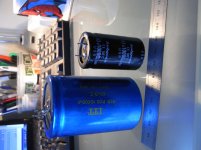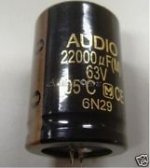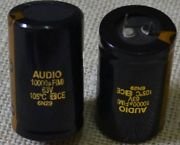Hi
When changing PSU caps in a 303, the capacitor clamps are invariably too large for todays smaller 2200uf 100v
I have found using the white cardboard suitable sized offcuts from surface mount caps like 0603 or 0805 size works well if you wrap it around the new cap then tighten up using the old brackets.🙂
A good bit of recycling too !
Hope this helps
Chris
When changing PSU caps in a 303, the capacitor clamps are invariably too large for todays smaller 2200uf 100v
I have found using the white cardboard suitable sized offcuts from surface mount caps like 0603 or 0805 size works well if you wrap it around the new cap then tighten up using the old brackets.🙂
A good bit of recycling too !
Hope this helps
Chris
I am very lazy. I bought replacement 35mm capacitors and a packet of plastic no flange capacitor clips from CPC (Part CA02864 - £1.65/5 pack),
these fit exactly on the existing chassis mounting holes using same screws 🙂
these fit exactly on the existing chassis mounting holes using same screws 🙂
Old bicycle innertubes work great. Cut some transverse sections, like fat rubber bands. Stretch them over the new cap. Layer as many as you need to get a tight clamp. They stay put during installation and are solid as a rock. And they don't look bad, either, especially with dark caps.
Bikes shops throw out bad innertubes that usually have plenty of "good rubber" for this purpose. Free. Even new tubes are cheap.
Bikes shops throw out bad innertubes that usually have plenty of "good rubber" for this purpose. Free. Even new tubes are cheap.
Are people fitting the replacement caps the other way up? - it was a modification from Quad to prevent electrolyte spilling on the PCB's (plus extending the wires to reach).
Yes, I believe that's what Quad recommended in the early days, when electrolytic capacitors were liable to burst and leak onto the pcb's below. My unit had a Quad re-cap service in 2001 and the replacement PSU and output capacitors are in the original orientation i.e. connections on bottom.
Maybe, capacitor manufacture has improved that this is not likely to be an issue. The fact that many high capacitance electrolytics now have pcb-mounting tags seems to confirm this. In any event, to turn the capacitors up-side down so that connections are on top is going to involve additional wiring. Not sure if that is going to add any sonic benefits to the already meagre bell-wire used in the 303 cable-looms🙂
Maybe, capacitor manufacture has improved that this is not likely to be an issue. The fact that many high capacitance electrolytics now have pcb-mounting tags seems to confirm this. In any event, to turn the capacitors up-side down so that connections are on top is going to involve additional wiring. Not sure if that is going to add any sonic benefits to the already meagre bell-wire used in the 303 cable-looms🙂
Yes, I believe that's what Quad recommended in the early days, when electrolytic capacitors were liable to burst and leak onto the pcb's below. My unit had a Quad re-cap service in 2001 and the replacement PSU and output capacitors are in the original orientation i.e. connections on bottom.
I did a few of them, with the mod kits supplied by Quad (Acoustic Manufacturing Co.) - back when they were a good company 😀
Maybe, capacitor manufacture has improved that this is not likely to be an issue.
Not sure about 'improved' 😀 - there's certainly lot's more capacitor failures than there were in the past, presumably because of the cheaper manufacturing techniques used on the poorer makes.
The fact that many high capacitance electrolytics now have pcb-mounting tags seems to confirm this. In any event, to turn the capacitors up-side down so that connections are on top is going to involve additional wiring. Not sure if that is going to add any sonic benefits to the already meagre bell-wire used in the 303 cable-looms🙂
As you say, pretty thin anyway 😀
I don't think it made any difference to the sound quality, and was still a great sounding amp.
Just to depress members here - back in the 70's I used to help run a rock club, and we had bands Friday and Saturday nights. A band turned up one night and for a PA they had 13 or 14 Quad 303 amplifiers, one of which had the top crushed in 😱 The depressing part was they were GIVEN them all 🙁
Yet more on capacitors, this time my stock QUAD 405 that got put to the side when I was playing and listening to the 303. I finally got round to replacing the PSU capacitors, the original ITT 10,000uF 63V electrolytics (date-marked 1978!) were definitely past their best though the only visible signs of fatigue was a slight bulging on the top of one of the pair. For a 36 year old capacitor, I think its fair to say the electrolyte had probably turned to sand 😉
I purchased a pair of 22,000uF 63V 105deg capacitors several months ago for another project. They were ridiculously cheap at £16 all in but when I received them I became suspicious they were Chinese fakes, as lots of people have reported. Anyway, feeling brave I fitted them into the 405 and replaced the ancient bridge rectifier with an up-to-date 25A version. So far so good....I have been giving the amp a pretty good burn in at high volume over last few days and nothing untoward yet. So, with a bit of luck they must either be genuine (highly unlikely based on their size and cost!) or they are essentially a 6800/10000/15000uF capacitor but with satisfactory voltage rating. I can certainly hear a massive improvement in the whole audio range, especially the bass but bearing in mind the age of the original capacitors that's probably to be expected.
I am not assuming I have dodged a bullet here but will continue to give the 405 a good thermal run in. At least, if something does go wrong the sturdy 405 case will probably give me better protection than a bullet-proof vest 😀
I purchased a pair of 22,000uF 63V 105deg capacitors several months ago for another project. They were ridiculously cheap at £16 all in but when I received them I became suspicious they were Chinese fakes, as lots of people have reported. Anyway, feeling brave I fitted them into the 405 and replaced the ancient bridge rectifier with an up-to-date 25A version. So far so good....I have been giving the amp a pretty good burn in at high volume over last few days and nothing untoward yet. So, with a bit of luck they must either be genuine (highly unlikely based on their size and cost!) or they are essentially a 6800/10000/15000uF capacitor but with satisfactory voltage rating. I can certainly hear a massive improvement in the whole audio range, especially the bass but bearing in mind the age of the original capacitors that's probably to be expected.
I am not assuming I have dodged a bullet here but will continue to give the 405 a good thermal run in. At least, if something does go wrong the sturdy 405 case will probably give me better protection than a bullet-proof vest 😀
Modern electrolytic caps are significantly smaller - around 30% of the volume of 1970s electrolytics. In the case of power supply and HV electros, this difference may be less due to insulating requirements. Generally though, the manufacturing standards of yesteryear have all shrunk. Even through-hole resistors are now designed to withstand higher temperatures so that they maintain their dissipation ratings as power levels increase.
Hi Ian,
You mean something like this.... 😀
I appreciate that high value capacitors have shrunk as manufacturing processes and materials have improved. However, based on the fact that equivalent capacitors from reputable, recognised sources are nearly twice the size and 8 times the cost, I am probably right to be a bit cautious. Also, the same eBay seller offers a 10,000uF 63V 105 deg in exactly the same livery (marking style/print) though slightly smaller diameter (30mm instead of 35mm) for same price😕. At best, I may have something around 10 - 15,000uF and (hopefully) the correct 63V DC rating. The capacitors are regulating at 53V DC in my 405. A basic RC time-constant test on the capacitor would give its true capacitance value. I suppose the lesson to be learned here is that unless you like playing Russian Roulette with your DIY audio upgrades, to be more rigorous in your choice of components than I was😱
You mean something like this.... 😀
I appreciate that high value capacitors have shrunk as manufacturing processes and materials have improved. However, based on the fact that equivalent capacitors from reputable, recognised sources are nearly twice the size and 8 times the cost, I am probably right to be a bit cautious. Also, the same eBay seller offers a 10,000uF 63V 105 deg in exactly the same livery (marking style/print) though slightly smaller diameter (30mm instead of 35mm) for same price😕. At best, I may have something around 10 - 15,000uF and (hopefully) the correct 63V DC rating. The capacitors are regulating at 53V DC in my 405. A basic RC time-constant test on the capacitor would give its true capacitance value. I suppose the lesson to be learned here is that unless you like playing Russian Roulette with your DIY audio upgrades, to be more rigorous in your choice of components than I was😱
Attachments
No, I haven't yet had problems with grossly exaggerated capacitance values, even though all electros have wide tolerances and some examples had blistered cans like ultra cheap zinc-carbon batteries. I have to admit, I have seen crap like pic 2, ticking all the boxes like 105C, 63V and more than 20 milliFarad. Sure, a few desirable figures but what is the other side of the coin?
The problems with cheap caps, apart from short service life expectancy is, if they are large value smoothing caps, ripple current rating will be low for their capacitance and if smaller value (< 2mF) will have high ESR and this isn't so good for decoupling, AC coupling, filtering and many audio roles. It undermines the point of having such high amounts of raw capacitance.
This doesn't mean they won't work in audio amplifiers but it it limits your amp to lesser quality sound at higher power and will need more frequent replacements to cover shorter expected lifetimes. Perceived sound effects of caps are another matter but even ignoring this, you still are on a losing streak with crapcaps.
If you are a UK native (can't be sure from your blank details) you can easily buy online or personally from many suppliers and some are much less than 8x the Ebay price of the products shown. Cricklewood have some good bargains but I pay about 2-3 x Ebay crapcap prices through Mouser or Digi-key for good, industry standard Panasonic grades but there are many options for even better quality if the application requires it.
In the end, standard products will deliver the most bangs/buck, whoever produces them.
The Quad 303 uses 100V caps which are not likely to appear from China at $5 US any time soon so owners need to buy respectable quality parts elsewhere anyway and they are not easy to source, being screw terminal or at least spade connector type.
Cap meters for big electros aren't that expensive now and any who are capacitor nuts who can't get enough of them, will have no difficulty buying and using one at every opportunity. Even my DMM will measure over 20 millifarad with acceptable accuracy.
The problems with cheap caps, apart from short service life expectancy is, if they are large value smoothing caps, ripple current rating will be low for their capacitance and if smaller value (< 2mF) will have high ESR and this isn't so good for decoupling, AC coupling, filtering and many audio roles. It undermines the point of having such high amounts of raw capacitance.
This doesn't mean they won't work in audio amplifiers but it it limits your amp to lesser quality sound at higher power and will need more frequent replacements to cover shorter expected lifetimes. Perceived sound effects of caps are another matter but even ignoring this, you still are on a losing streak with crapcaps.
If you are a UK native (can't be sure from your blank details) you can easily buy online or personally from many suppliers and some are much less than 8x the Ebay price of the products shown. Cricklewood have some good bargains but I pay about 2-3 x Ebay crapcap prices through Mouser or Digi-key for good, industry standard Panasonic grades but there are many options for even better quality if the application requires it.
In the end, standard products will deliver the most bangs/buck, whoever produces them.
The Quad 303 uses 100V caps which are not likely to appear from China at $5 US any time soon so owners need to buy respectable quality parts elsewhere anyway and they are not easy to source, being screw terminal or at least spade connector type.
Cap meters for big electros aren't that expensive now and any who are capacitor nuts who can't get enough of them, will have no difficulty buying and using one at every opportunity. Even my DMM will measure over 20 millifarad with acceptable accuracy.
I agree with all of that. As I said, lesson learned. At the moment, Lenny Kravitz and Elbow are beating the crap out of those caps and they are holding up ok....for how much longer is another matter.
- Status
- Not open for further replies.
- Home
- Amplifiers
- Solid State
- Quad 303 PSU caps mounting


